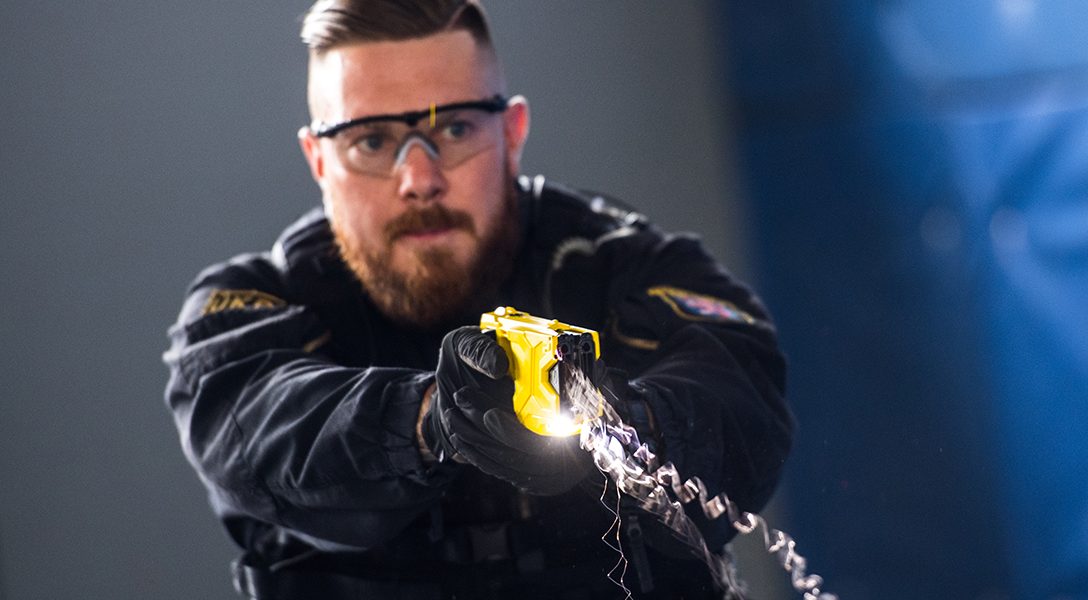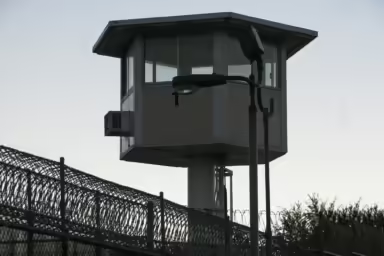Can tasers and electric pulse technology replace the need for traditional guns?
Has creative destruction finally come to the weapons industry?
What if we’ve got the gun debate all wrong? Instead of trying to control, register or take away guns, perhaps we should first look at the fundamental reasons guns are used in killing and violence.
In this week’s WhoWhatWhy podcast, we talk with Rick Smith, a Harvard graduate and University of Chicago MBA, whose company, Axon, is the world’s leading developer and maker of tasers.
According to Smith, in the vast majority of cases, guns are purchased for defense, or to stop a threat to property or person. Even police mostly use guns as a form of self-defense. So what if law enforcers and average citizens (and even criminals) all had a way to accomplish their goals without the use of lethal force? That’s where tasers enter the picture.
Originally developed by NASA, and now in their seventh generation, tasers just may be getting to the point where the technology is the answer to the gun problem.
Smith talks about the newest generation of these so-called energy weapons, how they have become more reliable, are better able to penetrate clothing and even have computer-assisted targeting.
He argues that the new tasers just might be a better tool for police officers, and the military.
As for criminals, if the goal is to reduce the number of gun deaths, it might be prudent to change the laws so that a perpetrator who uses a taser instead of a gun in the commission of a crime — thereby exposing the victim to less chance of bodily harm — gets less jail time if caught.
Indeed, some people think that the latest energy weapons, instead of being registered, should be mass distributed. Perhaps it’s no surprise that one of these people is the CEO and founder of Axon.
Click HERE to Download Mp3
Full Text Transcript:
As a service to our readers, we provide transcripts with our podcasts. We try to ensure that these transcripts do not include errors. However, due to time constraints, we are not always able to proofread them as closely as we would like. Should you spot any errors, we’d be grateful if you would notify us.
| Jeff Schechtman: | Welcome to the WhoWhatWhy podcast. I’m your host, Jeff Schechtman. |
| Jeff Schechtman: | If our economic and political debate today is about one thing, it’s about change, particularly with respect to jobs, the impact of technology, and the way that creative destruction, from self-driving cars to social media, is reshaping almost everything today. Why are we not also talking then about the end of violence and the end of killing and the end of guns, the end of inappropriate action on the part of law enforcement? |
| Jeff Schechtman: | In fact, my guest today, Rick Smith, has been talking and thinking about that for many years. As the CEO of Axon, his work with tasers and body-cams may very well be the way that law enforcement and even the military finally come full-bore into the 21st century. |
| Jeff Schechtman: | Rick Smith is the Founder and CEO of Axon, formally Taser International. He’s a graduate of Harvard with a BA in biology and earned his master’s in international finance and has an MBA from the University of Chicago. His new book is The End of Killing: How Our Newest Technologies Can Solve Humanity’s Oldest Problem, and it is my pleasure to welcome Rick Smith to the WhoWhatWhy podcast. Rick, thanks so much for joining us. |
| Rick Smith: | Awesome, thank you for having me on. |
| Jeff Schechtman: | One of the fundamental ideas that you talk about is that we’ve gotten the gun debate all wrong, that we need to be looking not just at how we control guns and what we do with them, but really the fundamental reasons guns are used in killing and violence. Talk about that first. |
| Rick Smith: | Yeah, I would say the problem is that we’re mired in looking in the rearview mirror at the past, when in fact we have major problems to solve. Usually, the way we solve them is through innovation and new approaches, and if you stop to think about it, the reason people use guns on each other is not to kill each other. At least that’s not the valid reason. It’s to defend themselves. And historically, that has meant killing another person, if you’re protecting yourself because it’s the only truly reliable way to stop that threat. That’s why police are not trained to shoot to kill. They’re trained to shoot to stop a threat. |
| Rick Smith: | And the big question I’m putting forth is what happens when we get to the point we have other technologies, you can imagine something like Star Trek’s phaser that is as effective at stopping a threat, maybe even faster and more effective than a piece of flying lead, and yet these new technologies won’t require that you kill someone to defend yourself. And I think that’s going to happen within the next 10 years or so. This will have major social implications for how we think about violence, how we think about police work, how we even think about fighting our wars. |
| Jeff Schechtman: | How do we think about it in terms of the offensive side, criminals using guns for example, people killing people because they don’t want to be identified or they don’t want somebody to reveal some information? How does it work in that regard? |
| Rick Smith: | Yeah, I don’t think that we’ll see the end of criminal behavior, and certainly there will continue to be some violence, but I think, if we can begin to shift the tools that are available to people. Even criminals, for the most part, when they’re using a firearm, it is to protect themselves and get out of the situation they’re in. So even in that case, I think we’ll see many criminals that would deescalate because, for them frankly, they know they’re going to spend less time in jail if they get caught if they end up using a weapon that doesn’t kill someone. |
| Rick Smith: | Now, there will still be some at the fringe that still kill each other, but I think we can make a major dent if we just give people a better tool because there’s very few sociopaths or psychopaths in this world that actually want to take another human’s life. |
| Jeff Schechtman: | Things like tasers have been around for a while. Police have carried them for a while. Why have they not solved the problem up until this point? |
| Rick Smith: | Well, frankly they’re not sufficiently technologically advanced yet, so my company makes these devices, and we’re quite proud of them, but they’re not at a level yet where they can truly compete with a handgun in terms of effectiveness and reliability. But we’re getting closer every year. |
| Rick Smith: | Firearms have had about a 500-year head start, and it does take time for new tech to catch up, but my belief is that, within the next couple of decades, we’ll see energy weapons actually scream right past these old shrapnel-firing devices, both in terms of effectiveness and safety, and of course they’re much more sort of human in that they let you protect yourself without having to take another person’s life. |
| Jeff Schechtman: | Talk a little bit about how the weapons, the tasers that are around now that we’re familiar with, how they work and what the future is, where it’s going technologically. What’s going to be different? |
| Rick Smith: | Well, the idea behind the taser energy weapons is that, instead of inflicting lethal wounds on somebody, the idea is to instead go after command and control. We use that with electricity. So, as you and I are talking right now, our brains are sending electrical signals all through our body, telling every muscle how to move, even our voice box, how to form words. And once you understand how that electrical system works, you can then find ways to disrupt it temporarily, and that’s what a taser does. It fires out two darts with wires attached that’s attached to a medical-grade power supply that’s in your hand, and it sends these electric pulses downrange. And when they go through the body, they cause the nerves and muscles to light up with electrical energy. |
| Rick Smith: | What you see, you’ve probably seen somebody hit on TV, it looks a bit like a seizure. Their muscles contract uncontrollably, and they become paralyzed while they’re being stimulated with that electric signal. And then, when it shuts off, you return right back to normal, other than there have been some cases of injuries from people during the fall and things like that. But over 99% of the time, people get right back up, and they’re right back to normal. |
| Jeff Schechtman: | Now, going forward, what are the technological advances that you’re looking to make with these weapons? |
| Rick Smith: | Well, we just made a fairly big one this past year. We’re on the seventh generation of taser weapons, and really it comes down to reliability. So the newest devices are more accurate. The darts fly straighter and hit harder so they penetrate the clothing better because ultimately, in order for this to reach the level of reliability where energy weapons could become the first choice, they need more shots. Today it’s a two-shot weapon, so you need to think about how you can get more shots than that in case you miss. They need to penetrate through clothing better. And we need to make sure that they’re extremely accurate. |
| Rick Smith: | We’re beginning to look at things like computer-assisted targeting too so that, when you’re aiming at the subject, we could put cameras in small onboard devices that could help aim the system to make sure you hit the target you’re aiming at. And as we combine those technologies together, we believe we can get well past the 99% effectiveness point, and at that point in time, then … |
| Rick Smith: | You think about it, if you’re a police officer, and you’re going into a building, and you have no idea what’s inside, if you have a gun in your hand, that is a very terrible situation to be in because now you open the door, you see something moving, it looks like somebody pointing something at you, and you now have to make an instant decision: Do I kill this person or not? And the fact of the matter is your brain hasn’t had time to process is that a 13-year-old with a cell phone or is that a gangster with a semiautomatic weapon? It all happens so fast. |
| Rick Smith: | And that’s where I’m finding tremendous reception from the police because officers themselves are saying, “Look, we don’t want to be in that situation, but today the only thing we have that we would really trust our lives in are these firearms.” And we just need to give them something better. |
| Jeff Schechtman: | In terms of criminals, the public getting these weapons, what are the cost issues involved? We certainly know how cheap and abundant handguns are today. |
| Rick Smith: | Yeah, as you would expect, it is more expensive than a gun, which is a fairly simple mechanical device. But taser weapons are available to the public as well, and they start at about $400, so it’s not as much as you might think. |
| Jeff Schechtman: | Talk a little bit about how police have been viewing these, what the feelings are about this weapon. What have you seen? What have you heard? |
| Rick Smith: | Well, whenever I’m at various conferences where I see lots of police officers, I get a lot of hugs, and that’s because I have cops come up to me all the time and tell me, “Hey, I didn’t have to kill someone because we had this technology.” Particularly, you’ve heard of the phenomenon ‘suicide by cop’ where you get an emotionally disturbed person, they get a knife or something, call the police, and then, when the police show up, they charge at the police, trying to get the police to shoot and kill them, and they’ll have a suicide note in their pocket. |
| Rick Smith: | That’s a great case where today taser weapons are frequently used because, in that case, many times the police arrive, they have time to assess the scene, sort of realize what’s happening, put the gun away, and they’ll transition to the taser weapon. The challenge is that, until they sort of get an assessment of what’s happening, today they usually start with the gun in their hand, and that’s the way it has to be until these other technologies can get a little bit further up the effectiveness curve. |
| Jeff Schechtman: | Is there a danger that, because they don’t kill, that they will be too quick, whether it’s the public defending their home or whether it’s police officers, too quick to use these weapons, and does it matter? |
| Rick Smith: | Oh, certainly that is a risk. I think, when we first began deploying tasers with police 15, 20 years ago, we saw that phenomenon happen where they called it taser dependence. Sometimes police officers, it was too convenient to just go right to the taser, and that’s one of the reasons that we now see police wearing body cameras. That was a tool that we also developed to actually oversee how police were using these devices to ensure that they weren’t being flippant in their use. So now that we record all these incidents, I think we’ve seen it tone things back down. |
| Rick Smith: | But there is a little bit of a risk that, as things become less deadly, it is easier to use them. I would argue that the number of lives saved is certainly worth the risk. We don’t want to keep deadly things around just because … them being deadly is kind of a terrible feature to rely on to throttle their use. |
| Jeff Schechtman: | The other question with respect to this is how the criminal justice system is going to deal with it. If somebody uses a taser in the commission of a crime, shoots a police officer, shoots an innocent bystander, shoots a victim, how will … and that victim survives, even though it’s in the commission of a crime, how will the criminal justice system deal with that? |
| Rick Smith: | Yeah, they would deal with it the same way they would deal with any other sort of violent assault. Most violent assaults are not deadly, thank goodness, but they still carry significant criminal penalties, whether you assault someone with a baseball bat, with your hands. Whether you attacked them with anything, you can be convicted of assault, and a taser weapon is no different. |
| Rick Smith: | Now, you are likely to get less penalties than if you killed someone, but I think that’s sort of the rational system at work. If you actually want to think of it in terms of incentives, you certainly want the harshest penalties against people who do the most harm. So, if criminals do deescalate, this actually does incentivize them to do things that at least don’t hurt and injure people. And while there’s some risk it could be misused, I would far rather be tased than shot if somebody was going to rob me. |
| Rick Smith: | And the fact that these electronic devices actually do give us the ability to add some additional deterrents, so these devices, for example, are serial numbered, and they leave confetti with your identification of your device behind every time it’s used. And then, because it’s electronic, we also save logs of how it’s used, so we have evidence later that can prove or disprove when the device has been used. So we do try to layer in those deterrents to avoid people misusing these things. |
| Jeff Schechtman: | Does that become a deterrent for criminals to use them, that they are so traceable as opposed to cheap handguns, for example? |
| Rick Smith: | Yeah, that’s the intention. It’s actually been interesting. I was in Minnesota many years ago. They were debating what laws to put in place, and a quite liberal senator who normally you would think would be in favor of tighter regulation on these types of devices came out and said actually he was against forcing registration laws in the state, and part of his rationale was “Look, we have criminals that are going out and buying guns. We actually don’t want to make it so difficult to buy these, that it scares them away.” |
| Jeff Schechtman: | Right. |
| Rick Smith: | “We’d rather have criminals that are deescalating from guns to these other devices would be a step in the right direction.” |
| Jeff Schechtman: | Can these devices, these taser devices, these electronic pulse devices, can they be lethal? You were using the example before of a 13-year-old accidentally being shot with one. At what point can these be lethal weapons? |
| Rick Smith: | So one of the amazing things about electrical energy is that it has a very high safety margin between the level we need for it to be effective and where it becomes lethal is typically between 10 times and 100 times the energy output. |
| Rick Smith: | Now, that’s not to say they’re risk-free. The primary risks actually relate to injuries from falls, so we’ve seen, over the past 20 years, about three to four million field uses of these devices, and there have been some deaths, about approximately 20, from people that have fallen down and sustained a head wound or something like that. They can also ignite flammables because there is a spark of electricity, so sometimes in a methamphetamine lab or an environment like that, it can actually spark a fire. Those are other risks. |
| Rick Smith: | And then finally, they are stressful. Now, there’s a lot of concern about cardiac safety, but we have tremendous advisors from some of the world’s leading cardiologists that will tell you it is extremely unlikely that this could cause a cardiac event, but the risk is not zero. If you had somebody who really had a severe medical condition, under the right circumstances, you might get some sort of adverse outcome. But overall, their injury rate’s less than 0.3% of the time, which is far less certainly than guns or even batons. |
| Jeff Schechtman: | This technology has been around for a while. In fact, you talk about it was originally developed by NASA. Why hasn’t it developed further faster? |
| Rick Smith: | Yeah, remember the first cell phones came out in the late ’70s, and it took a couple of decades for the technology to become reliable enough to take off. And I think the same thing happened here. The early generations were big and bulky and super buggy, so it took about three decades until we finally got all of the technology dialed in. And then, over the past 20 years, we’ve made good progress, but I’m really trying to light a fire that it’s time for us to accelerate these capabilities and get to the point where they become an actual substitute for lethal force. |
| Jeff Schechtman: | We’ve talked about it a lot with respect to law enforcement. What have you seen in terms of adoption and reaction from the military? |
| Rick Smith: | So the military’s been actually quite slow to adopt this technology. I think there’s a couple reasons. One, the military is a very large organization, and large organizations are just slow to change. The second one is interesting in that actually a lot of anti-war activists have actually come out and protested vehemently against the military using non-lethal weapons, which to me is pretty counterproductive. |
| Rick Smith: | My son served in Afghanistan, and we send our young men and women overseas armed to the teeth with things that kill people, and yet, when a 12-year-old potential suicide bomber walks up on a U.S. checkpoint, we have no way to stop that person without killing them. And I’ve talked to many soldiers that have been in that situation and have actually killed children or pregnant women, and it is a horrific thing, both obviously for the local community and for the military and for the members to go through that. |
| Rick Smith: | So part of the other reason for this book is, in the types of conflict we’re in today, we certainly need our lethal military options, but those aren’t the right tool for everything that we face. We need better non-lethal options, and I’m hopeful that this concept is starting to gain traction in military leadership circles, understanding our men and women need more than just the ability to kill when we send them overseas. |
| Jeff Schechtman: | Is there an increased level of technology potentially for military-grade weapons? |
| Rick Smith: | Yeah, there is. The third element for the military is they really need to be able to reach out to a greater distance, where police, they only need about a 10-to-20-foot range because they’re dealing with people up close. With the military, particularly for those suicide bomber type threats, they want to be able to reach out about 300 feet, so there are things we need to do to extend the range, and that’s another area of research we’re working on right now. |
| Jeff Schechtman: | It seems like, particularly with respect to military uses, that the intelligence community would like these weapons because it would really encourage people to be captured as opposed to killed. |
| Rick Smith: | Absolutely. I believe we can’t kill our way to success in the types of conflicts we’re seeing in this century. The most precise lethal weapons we have, you still get it wrong sometimes. If we kill the wrong person, like when we drop a bomb on a wedding party that we had bad intel and we thought it was a terrorist gathering, that is absolutely catastrophic to U.S. interests because it turns the local communities against us. It undermines support at home. |
| Rick Smith: | And then ultimately, what we’re dealing with here, the most powerful weapon we have is intelligence, so if we can capture even a terrorist, which you might say, “Well, some people need to be killed” is a quote that I hear. But then, when you dig a layer deeper, almost any military expert will say, “You know what, if we could capture them alive, that’s way better because it gives us the ability to interrogate them.” And it deprives them of this sort of myth of martyrdom, where the types of organizations that we’re combating now use martyrdom as a recruiting tool. When somebody dies, it becomes this celebrated, heroic event. You deny them that when you capture someone and you take them off to a military prison for the rest of their lives. |
| Jeff Schechtman: | Talk about the reality of these weapons in terms of needing to be upgraded with respect to technology. Police departments buy them and suddenly there’s a new generation or new software or new technology. We see that with our phones every single day. Is there a greater ongoing cost to all of this that’s not being factored in yet? |
| Rick Smith: | Well, that is a great question because, yeah, a taser weapon is probably more like your smartphone than a hammer or some other simple tool. These do have software, so our latest generation actually come with a data doc that you plug in and recharge the batteries, and it does data transfers and updates the software in the device. |
| Rick Smith: | So we actually find the majority of our customers now go on a subscription plan, much like you might with your iPhone, right? Most people don’t buy their phone anymore. They just sign a two-year plan, and they get the phone, and then at the end of the plan, they sign another one, they get a new phone. That’s the same economic model now that most police departments do with taser weapons. That way they get all the services included, and they have the budget line item ready to go, so in a few years, when we launch a new taser weapon, they just sign a new contract, and we upgrade the device, and the service keeps going. |
| Jeff Schechtman: | You are also in the body-cam business and have been really the leader in police using and adopting body-cams. Talk a little bit about that. |
| Rick Smith: | Yeah, we got into the body-camera business precisely to address the potential for misuse. But what we’ve come to realize is body-cameras are useful for a heck of a lot more than just overseeing the taser weapons. We can record every police incident and make sure not only to protect the public by documenting how police are treating the public. We actually also protect police where they get accused of all sorts of terrible things, and most of the time it’s just not true. |
| Rick Smith: | You talk to any criminal defense attorney, and they’ll tell you the first thing they do when they get a client who’s been arrested by the police is they’ll file claims against the police so that they have sort of their own offense in each case. So these cameras really do help protect police officers because it records what actually happened. |
| Rick Smith: | And then, on the back-end of that, you can imagine there is a ton of data that has to be handled. When we have about 300,000 of these cameras being used everywhere from NYPD to LA and Chicago, that is just a massive data-handling challenge. We have a service that does all of that for police so that they don’t have to get in the business of figuring out how to run their own local video data centers. |
| Jeff Schechtman: | Talk a little bit about how AI is being incorporated into this. |
| Rick Smith: | So, if you think about a police incident, and we record it on video, we have the best record imaginable. We have a video of what happened. But then, after that incident, a police officer has to go fill out three, four, five different reports, and it turns out that cops spend over half of their day sitting at a computer typing up reports. |
| Rick Smith: | Well, as we all know from artificial intelligence, it’s getting pretty good at recognizing our voice commands. The promise of AI is that we could take these videos, feed them into a computerized system that can listen to everything and help write the report. Obviously, a police conversation is pretty structured. “Sir, what’s your name?” And then we know that the next few words are likely to be the first name and last name of the individual. |
| Rick Smith: | So we’re building AI systems that will convert the information that’s in these videos into the first draft of a police report, and we believe we can cut the amount of time police spend on bureaucracy by at least half. And that would effectively about double the police force in terms of the amount of time they can spend doing police work. We just cut them free from all the bureaucratic overhead. So that’s probably the most exciting thing happening in the body-camera space in the next 10 years. |
| Jeff Schechtman: | What about with respect to AI looking at all of these incidents, ones that result in shootings or violence, and even those that don’t? Because there are so many, because the penetration of body-cams is so high today among police departments, can we learn something from all of this data that you’re collecting with respect to how police act? |
| Rick Smith: | We can. We can absolutely do things like look for warning signs. What are the patterns that happen in officers that break down and become abusive? Can we identify those patterns earlier and help agencies intervene? We can also look for patterns of criminality in the data out in the neighborhoods to help deploy resources from police more effectively. |
| Rick Smith: | And I will point out this is … we have to be quite careful in using AI and any of these technologies because we’re really talking about people’s privacy and civil liberties. So one thing we did that’s a bit unique, we created an AI ethics board that includes not only some police, but some of the forward-leaning civil liberties groups that are helping us to think through how do we use this data to make communities safer and protect our civil liberties at the same time? We certainly don’t want to be involved in building something out of a George Orwell novel where the government is just surveilling everyone all the time. That’s not the world we want to live in. But we do want police to be more informed and more data-driven. |
| Jeff Schechtman: | What pushback have you found so far to body-cams, to all of what we’ve been talking about really, in terms of the way that private industry is getting into so many aspects of the law enforcement business? |
| Rick Smith: | Yeah, I think, from some angles, there’s a knee-jerk reaction that “Wait a minute, why is private industry managing the data?” But, if you dig in, there are 18,000 police agencies in the United States, and they are all agencies, part of your local city government. They simply do not have the capacity to go out and develop technology like body-cameras or write in management software to manage all this data. |
| Rick Smith: | So just like police agencies use Microsoft Windows, they don’t write their own software, similarly they use evidence.com, which is our service because we can just do it at scale, and we can serve all 18,000 agencies out of one cloud-based system that can be far more secure and a lot more cost-effective than if every agency tried to do it themselves. |
| Jeff Schechtman: | And what are you seeing, if any, with respect to a nexus between what you’re doing with tasers and the body-cam business? |
| Rick Smith: | Well, there’s a lot of overlap. One of the most basic ones is you want to make sure you record every time a taser is used. So the tasers and the body-cameras talk to each other wirelessly. So if you activate a taser weapon, it will send a signal to make sure that your camera turns on. And then, on the back-end, we make sure that all of the evidence, whether it’s the logs from the tasers, some photos from your smartphone, or the video from the body-camera, that those are all collected together on the back-end into one case folder. So it makes it much easier for agencies to keep track of all their evidence. |
| Jeff Schechtman: | Talk a little bit about how you personally got involved in this business. |
| Rick Smith: | Well, back in 1990, I had a couple of friends that were shot and killed in a road rage incident right here in Scottsdale, Arizona. And I just became very passionate about the gun violence problem. To me, I didn’t want to just get angry about it and write letters to people. I wanted to do something. So, for me, the path was pretty simple. If we could invent something better than a gun, that’s the best way to get people to stop killing each other is to just make the whole idea of shooting bullets at people obsolete. And that’s what I’m spending my life trying to do. |
| Jeff Schechtman: | Rick Smith, he’s the Founder and CEO of Axon, formally Taser International. He’s the author of the book, The End of Killing. He’s at the cutting edge of energy weapon technology. Rick Smith, thanks so much for being with us today on the WhoWhatWhy podcast. |
| Rick Smith: | Thanks, it’s been wonderful to share the vision, and truly the world is getting safer, despite what you see on the news. The amount of killing in the world has already gone down dramatically the past couple centuries, and we’re going to drive it down pretty close to zero. |
| Jeff Schechtman: | Thank you so much. |
| Rick Smith: | All right, thank you. |
| Jeff Schechtman: | And thank you for listening and for joining us here on Radio WhoWhatWhy. I hope you join us next week for another radio WhoWhatWhy podcast. I’m Jeff Schechtman. If you liked this podcast, please feel free to share and help others find it by rating and reviewing it on iTunes. You can also support this podcast and all the work we do by going to WhoWhatWhy.org/donate. |
Related front page panorama photo credit: Adapted by WhoWhatWhy from US Air Force and US Marines.






